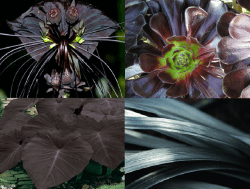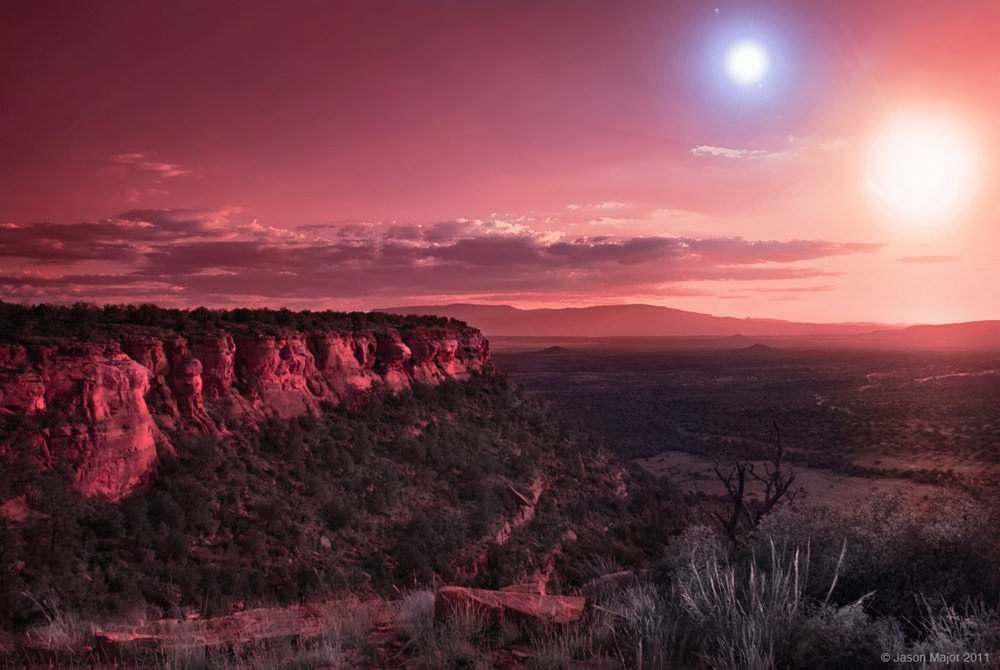[/caption]
The grass may definitely not be greener on some alien worlds, suggests a new study from the UK. For example, planets in double-star systems could have grey or black vegetation.
Researcher Jack O’Malley-James of the University of St Andrews in Scotland worked out how photosynthesis in plants is affected by the color of the light they receive. On Earth, most plants have evolved to be green in order to take advantage of the yellowish color of the sunlight that’s received on the surface of our planet. (Our Sun, classified as a “Population I yellow dwarf star”, would look bright white from space but our atmosphere makes it appear yellow.) There are lots of other stars like our Sun in the Universe, and many of them are in multiple systems sharing orbits with other types of stars…red dwarfs, blue stars, red giants, white dwarfs…stars come in many different colors depending on their composition, age, size and temperature. We may be used to yellow but nature really has no preference! (Although red dwarfs happen to be the garden variety star in our own galaxy.)

Planets that orbit within these multiple systems and exist within the habitable “Goldilocks” zone (and we are finding more and more candidates every day!) could evolve plants that depend on suns with different colors than ours. Green does a good job powering photosynthesis here, but on a planet orbiting a red dwarf and Sun-like star plants could very well be grey or black to absorb more light energy, according to O’Malley-James.
“Our simulations suggest that planets in multi-star systems may host exotic forms of the more familiar plants we see on Earth. Plants with dim red dwarf suns for example, may appear black to our eyes, absorbing across the entire visible wavelength range in order to use as much of the available light as possible.”
– Jack O’Malley-James, School of Physics and Astronomy, University of St Andrews
The study takes into consideration many different combinations of star varieties and how any potential life-sustaining planets could orbit them.
In some instances different portions of a planet may be illuminated by a differently-colored star in a pair…what sorts of variations in plant (and subsequently, animal) evolution could arise then?
And it’s not just the colors of plants that could evolve differently. “For planets orbiting two stars like our own, harmful radiation from intense stellar flares could lead to plants that develop their own UV-blocking sunscreens, or photosynthesizing microorganisms that can move in response to a sudden flare,” said O’Malley-James.
Kermit may have been right all along…being green might really not be easy!
Read more on the Royal Astronomical Society’s news release or on the University of St Andrews website.
Top image credit: Jason Major


There are a number of photoactive molecules. The photoactive molecules rhodopsin is a range of such biomolecules, which are responsible for vision. The energy of a photon changes the shape of the molecule which converts the energy of that photon by the transformation of ADP to ATP. There are some prokaryotes with photoactive molecules that have a range of colors. The colors that appear in these molecules represent the photons which are “rejected.” Chlorophyll rejects green (400 nm) photons, but absorbs largely yellow to red, which is a large chunk of the black body spectrum of the sun. Some photoactive chemicals are colored violet and red. So on Earth there are molecules, which transform some photons in to energy usable by organisms. The photosynthetic system with chlorophyll is a highly evolved system that has dominated the other with eukaryotes and the plant kingdom subset therein.
On a planet around a K to M class star it might be that a violet form of photoactive molecule similar to that on Earth would be selected for. On a world with a red star there would be few blue (3-400nm) photons, so the sky would be black at day, and plants with violet or even chlorophyll green photosynthetic molecules would appear grey or black. Dusk with a nice red sunset it is evident trees do not appear that green.
LC
Thanks for all that cool extra-sciency stuff!
Really fascinating! It makes me hungry for more informations about it. More examples or combinations. More pics. Also, computer games come to mind.
The link at the end of the article has another link! With more pics!
http://www-star.st-and.ac.uk/~jto5/Images/
It’s very interesting how they don’t have a night at some part of a year. And at other part of a year they have 2 other things besides a night and a day.
definitely intriguing. love articles like this.
Eversince, it never came up on my mind that earth is the only habitable planet in the whole creation. my goodness, just imagine how many suns we have and planets for that reason? whatever the color is, the type is, the kind is, of the alien life we will encounter, still, its alien isnt it? The man who knows everything, everything about alien life is the president of the US of A. He knows every bit. And the people of NASA of course plus the people of universe today who I cannot understand why they keep on covering up informations about aliens. The can send spacecrafts in outer reaches of the solar sysyem but they cannot send man on the moon which is just next door! Of course, the Apollo moon landing is a hoax for me, why? it was not repeated again within 50 years of time. About mars, they keep on showing us old photos specially with regards to its two moons. I wish NASA and Universe Today will be honest enough to tell the truth, then we will feel that they consider us not second hand citizens.
Extraordinary claims require extraordinary evidence. Please direct us to a substantial piece of objective evidence that will sway us to believe you. This has to be something we can independently measure and verify for ourselves. Grainy video of flashing lights in the sky and wildly speculative news articles do not meet the very high burden of proof required for a scientist to take claims of intelligent alien visitation seriously. As in a court of law you have to prove your case beyond reasonable doubt to win a conviction.
Don’t feed it! 😉
“Of course, the Apollo moon landing is a hoax for me, why? it was not repeated again within 50 years of time.”
The Apollo space program was terminated for a number of reasons. Firstly, the cost of sending a manned mission to the Moon was astronomical (no pun intended). The program’s cost were recently recalculated (in 2005 dollars) at around 170 Billion! Secondly, the public was loosing interest. Thirdly, the space race was ending, the Soviets had lost the Moon race, and what’s more, seemed unable or unwilling to invest the resources necessary to perfect their super-heavy lifter the N1 rocket. NASA’s budget was reduced also. Finally, other space projects such as the Space Shuttle and Skylab were coming to the fore.
Apollo is no hoax – I assure you. Every single reason why people believe it is a hoax are based wrong. Name any reason and it is refutable.
As for aliens on Earth, there is no serious body of evidence that provides any indication that lifeforms have visited Earth. Period. Moreover, I’d like to add that there isn’t any real reason for aliens to travel here. I’m not going to go into this much as I stopped reading when you accused UT of a coverup (sorry UT you aren’t THAT special! ;)).
It is an interesting subject, which leaves me a bit annoyed that this is a press release on an oral presentation of a PhD student without any tangible result. Add to that annoyance with that much of what is touched on _do_ occur already here (organisms covering the irradiation efficiently, using sunscreen pigments, et cetera) and that the illustrative dark plants shown have other reasons for their color.
– Photosynthesis as such can be, and is, used over a large part of the spectrum. Archaea uses far IR pigments to derive energy for metabolism. Similarly pigments are used for sunscreens of various spectral ranges in plant leaves as in carotenoids, for example. [I made a fairly densely referenced series of posts on this in a thread somewhere not long ago, I may try to find it later.]
– Oxygenating photosynthesis, the interesting kind that can drive both carbon cycles and multicellular life, is more restricted. On Earth at least, plants use a two-photon synthesis chain with chlorophylls to efficiently capture energy over the visible window.
These photosystems are preferentially absorbing yellow-red as LBC notes, but one uses an antenna complex to supplementary capture all wavelengths of visible light. Green is the remainder after red and blue is absorbed, smack in the middle of the energy (= frequency) range at ~ 500 nm wavelength if I’m not mistaken. As such it is a sign of efficiency, a remainder balanced between maximizing absorption of many reds and fewer but more energetic blues.
– Due to competition, photosynthesizers have developed different chlorophylls to maximize efficiency. As a result different species of cyanobacteria can grow in layers, each underlying one using the remainder of the above absorption. Just last year a 4th layer using chlorophyll f to maximize light capture in the near IR was discovered. Those would do well on M stars, and use speciation to do what O’Malley-James suggest for single species.
– Also, characteristics of Earth plants are not a good template for predicting photosynthesis efficiency. The key enzyme in the remaining carbon fixation of plants, RuBisCO, is terribly inefficient. As a result it is the most abundant protein on Earth, around 50 % of leaf protein content, and a major nitrogen sink.
Inconveniently, in RuBisCO carbon fixation action is in competition with oxygen! (A sign that it was developed before oxygen was a dominant environmental component. Well, duh.) “At ambient levels of carbon dioxide and oxygen, the ratio of the reactions is about 4 to 1, which results in a net carbon dioxide fixation of only 3.5. Thus, the inability of the enzyme to prevent the reaction with oxygen greatly reduces the photosynthetic capacity of many plants.” [Wikipedia; no, I don’t get that the fixation figure mean.]
If light absorption in itself had been limiting (instead of oxygen ambient and competition, respectively), we had likely seen different colors on pigments. As it is, many of the stars will likely have a sufficient irradiation precisely at the zone where planets are habitable. (Though I would like to see that verified.)
– Why plants have non-green colors on leaves that may or may not be used for photosynthesis (say, summer vs autumn foliage) is still debated. It doesn’t seem to be related to photosynthesis much, and I bet some of the images shown are results of artificial selection for color.